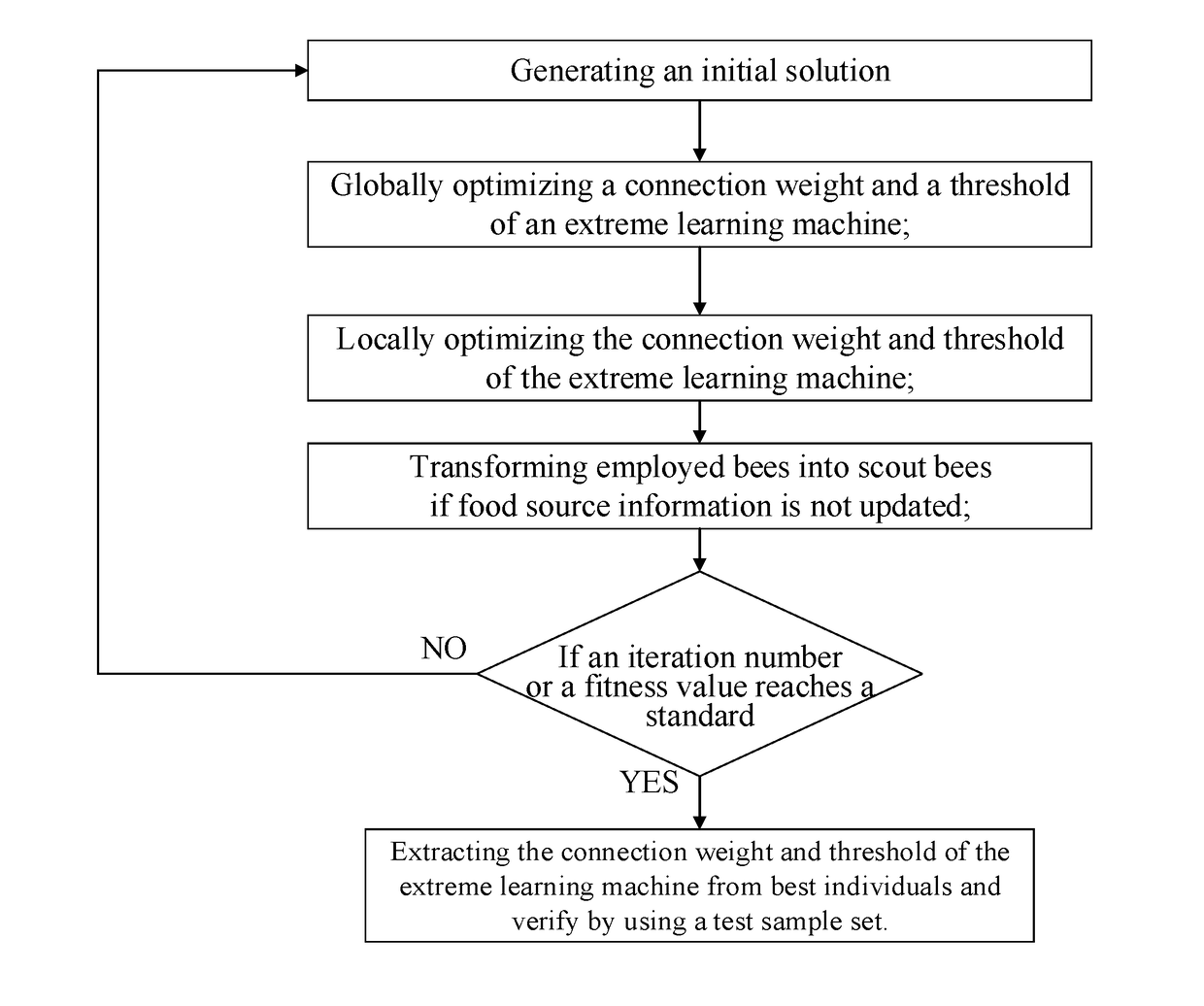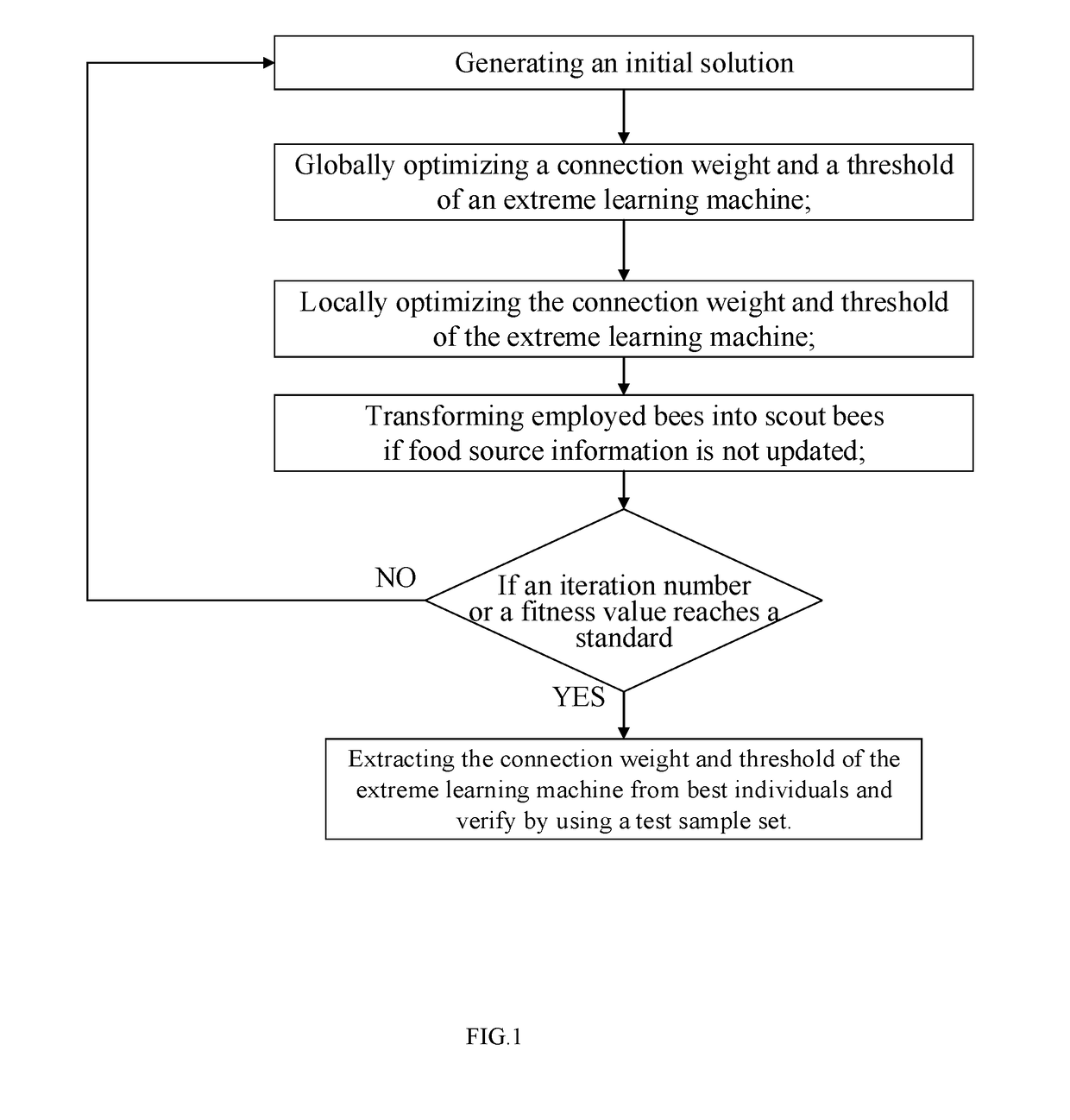Improved extreme learning machine method based on artificial bee colony optimization
a learning machine and optimization technology, applied in the field of artificial intelligence, can solve the problems of slow training speed, easy coverage to local minima, and easy occurrence of requirements for setting more parameters, and achieve the effect of improving the results of classification and regression and high robustness
- Summary
- Abstract
- Description
- Claims
- Application Information
AI Technical Summary
Benefits of technology
Problems solved by technology
Method used
Image
Examples
embodiment 1
xperiment of Sin C Function
[0066]An expression formula of the Sin C function is as follows:
y(x)={sinx / x,x≠01,x=0
[0067]A data generation method is as follows: generating 5000 data x uniformly distributed within [−10, 10], calculating to obtain 5000 data sets {xi,f(xi)}, i=1, . . . 5000, and generating 5000 noises ε uniformly distributed within [−0.2, 0.2] again; letting a training sample set as {xi,f(xi)+εi}, i=1, . . . 5000, generating another group of 5000 data sets={yi,f(yi)},i=1, . . . , 5000 as a test set. The number of hidden nodes of four algorithms is gradually increased for function fitting, and ABC-ELM and DECABC-ELM algorithms are same in parameter setting. The results are as shown in Table 1.
TABLE 1Comparison of fitting results of SinC functionNumberofPerfor-SaE-PSO-DEPSO-ABC-DECABC-NodesmanceELMELMELMELMELM1RMSE0.35580.35610.35610.35610.3561Std. Dev.0.00070000.00012RMSE0.16130.16940.20110.23560.1552Std. Dev.0.01750.02700.07820.10000.01703RMSE0.15710.15240.15030.18710.144...
embodiment 2
xperiment of Regression Data Set
[0087]4 real-world regression data sets from the Machine Learning Library of University of California Irvine were used to compare the performances of the four algorithms. The names of the data sets are Auto MPG (MPG), Computer Hardware (CPU), Housing and Servo respectively. In this experiment, the data in the data sets are randomly divided into a training sample set and a test sample set, with 70% as the training sample set and 30% remained as the test sample set. To reduce the impacts from large variations of all the variables, we perform normalizing on the data before the algorithm is executed, i.e., an input variable normalized to [−1, 1], and an output variable normalized to [0, 1]. Across all the experiments, the hidden nodes gradually increase, and the experiment results having the mean best RMSE are recorded into Tables 2 to Table 5.
TABLE 2Comparison of fitting results of Auto MPGTest SetTrainingNumber ofAlgorithm NameRMSEStd. Dev.Tie (s)Hidden...
embodiment 3
xperiment of Classification Data Sets
[0090]The Machine Learning Library of the University of California Irvine was used. The names of the four real-world classification sets are Blood Transfusion Service Center (Blood), E coli, Iris and Wine respectively. Like that in the classification data sets, 70% of the experiment data is taken as the training sample set, 30% is taken as the testing sample set, and the input variables of the data set are normalized to [−1,1]. In the experiments, the hidden nodes gradually increase, and the experiment results having the best classification rate are recorded into Tables 6 to Table 9.
TABLE 6Comparison of classification results of BloodTest SetTrainingNumber ofAlgorithm NameAccuracyStd. Dev.Time (s)Hidden NodesSaE-ELM77.2345%0.00638.241914PSO-ELM77.8610%0.00825.03268DEPSO-ELM77.9506%0.00854.89079ABC-ELM77.4200%0.01275.821910DECABC-ELM79.7323%0.01525.73549
TABLE 7Comparison of classification results of EcoliTest SetTrainingNumber ofAlgorithm NameAccu...
PUM
 Login to View More
Login to View More Abstract
Description
Claims
Application Information
 Login to View More
Login to View More - R&D
- Intellectual Property
- Life Sciences
- Materials
- Tech Scout
- Unparalleled Data Quality
- Higher Quality Content
- 60% Fewer Hallucinations
Browse by: Latest US Patents, China's latest patents, Technical Efficacy Thesaurus, Application Domain, Technology Topic, Popular Technical Reports.
© 2025 PatSnap. All rights reserved.Legal|Privacy policy|Modern Slavery Act Transparency Statement|Sitemap|About US| Contact US: help@patsnap.com



